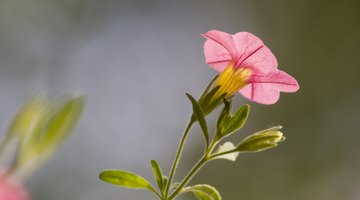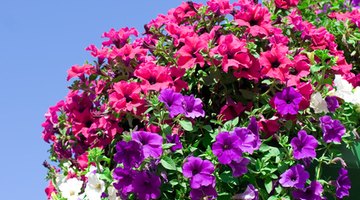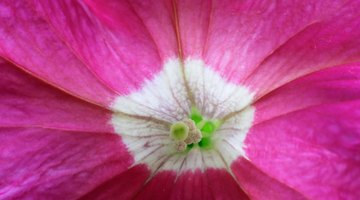Being easy to grow, petunias have found favour among home gardeners. Enthusiasm for the flower has inspired a lot of breeding, with the result that many variations on the basic petunia are available. Some can be grown as ground cover, others in miniature -- handy for pots -- and others with a lot of showiness to the petals. A petunia is funnel-shaped and, unless it has been specially bred, will have four sets of parts arranged in concentric circles.
Calyx

The four parts petunias might possess are always in the same order, starting with the calyx on the outside. It sits atop the stem, serving as a sort of pedestal for the rest of the petunia blossom. The calyx is composed of sepals, structures that are somewhat like leaves. Before a petunia opens, sepals enclose the bud, protecting the innards of the flower from harm.
- The four parts petunias might possess are always in the same order, starting with the calyx on the outside.
Corolla

The corolla of any flower is easy to distinguish since it is composed of petals. The petals, like the calyx, also have a protective function, helping to shield the two inner rings of flower parts. Petals also serve to attract pollinators.
Cultivation has led to petunia varieties with quite fancy corollas, including those possessing ruffled petal edges. A group of petunias called grandifloras may be double flowers, that is, they may have more than one round of petals. Multiflora petunias are smaller than grandifloras and are also available as double flowers.
- The corolla of any flower is easy to distinguish since it is composed of petals.
- A group of petunias called grandifloras may be double flowers, that is, they may have more than one round of petals.
Strictly speaking, petals and sepals aren't absolutely necessary for a flower -- after all, they aren't directly responsible for reproduction. Thus, petals and sepals are considered accessory parts of the petunia. Together, the two are called the perianth.
Androecium
Androecium is the term used to refer to the male parts of a petunia, the stamens. Stamens create pollen, which contain sperm. Each stamen has two parts. At the top is the anther, which is roughly shaped like a capsule. These are the source of pollen. Holding the anther aloft is a stemlike structure called the filament.
- Androecium is the term used to refer to the male parts of a petunia, the stamens.
- At the top is the anther, which is roughly shaped like a capsule.
Gynaeceum

The gynaeceum is the female reproductive part of the petunia. Eggs await pollination deep within these organs. Pollination means the sperm reaches the eggs, fertilisation occurs and seeds follow. Varieties created by man, though, can be sterile.
- The gynaeceum is the female reproductive part of the petunia.
Because the petunia has both a male androecium and a female gynaeceum, the flower is a hermaphrodite. Additionally, possessing the four basic parts possible for flowers means the petunia is also what is termed a "complete" flower.
